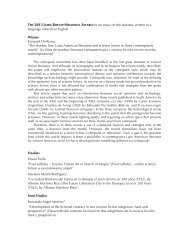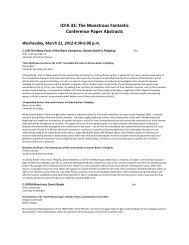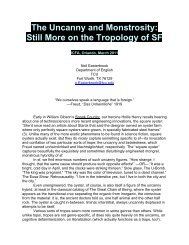The Monstrous Fantastic Conference Paper Abstracts - International ...
The Monstrous Fantastic Conference Paper Abstracts - International ...
The Monstrous Fantastic Conference Paper Abstracts - International ...
You also want an ePaper? Increase the reach of your titles
YUMPU automatically turns print PDFs into web optimized ePapers that Google loves.
17. (H) Brit Split (Personality) Lit Vista BChair: Leigha McReynoldsGeorge Washington University<strong>The</strong> Divided Self: Exploring Spiritual Tensions in Charlotte Brontë’s NovelsMichelle LattanzioIndependent Scholar<strong>The</strong> concept of the “divided self” is a prominent trope in Victorian literature, as noted in general terms by Masao Miyoshi in <strong>The</strong> Divided Self: APerspective on the Literature of the Victorians and more specifically as it applies to women’s studies by Nina Auerback in Women and theDemon: <strong>The</strong> Life of a Victorian Myth. This trope of the divided self, particularly as it applies to the split between “reason” and “passion,” is wellillustratedin the work of the Brontë sisters. Reason in these works tends to be aligned with the predominating Judeo-Christian, patriarchalworldview of the times, and passion is generally illustrated in woman-centric pagan terms and symbols. In Charlotte Brontë’s Villette, JaneEyre, and Shirley, tensions abound between and within the realms of Christianity and Paganism. Alternatively Christians are portrayed asspiritual monstrosities and heroic spiritual proclaimers, as in the characters of St. John in Jane Eyre, and Caroline’s Uncle Helstone in Shirley,and the complicated figure of the Nun in Villette. Pagans and pagan characterizations are also proclaimed in this fashion, in the characters ofRochester in Jane Eyre, Shirley in the novel of the same name, and the actress Vashti in Villette. In addition to characters and spiritual beliefs,these characterizations of spiritual monstrosities also applies to the spaces in these texts, notably Nunnely Woods and the Rectory in Shirley,the house in Jane Eyre, and the pennsionnat and attendant garden in Villette. <strong>The</strong> paper will concentrate on the complicated and complexspiritual monstrosities, both Christian and Pagan, that appear in Villette, Jane Eyre, and Shirley.Dance with the Vampire: Lady Geraldine, Vampirism, and the Gothic Imagination in Coleridge’s ChristabelMark De CiccoGeorge Washington UniversityFrom its earliest incarnations, Gothic literature has been marked by the struggle between rationality and the powers of imaginative thought.Can the supernatural be explained away with reason? Can the Gothic monster be defeated by way of cool, rational thought? <strong>The</strong>se questionsrecur in the Gothic tale from Walpole to Stoker and beyond. Though Samuel Taylor Coleridge is not the first author to come to mind when onethinks of the English Gothic, in this paper I will show that Coleridge’s Christabel is clearly a part of this tradition, and a prototype for the Englishvampire story as later developed by Le Fanu and Stoker. In Coleridge’s Christabel, the Gothic imagination subverts the supremacy of rationalityas the dominant, ruling function of the human psyche. Coleridge presents this threat through the vampiric Lady Geraldine—a figure who feedson irrational thoughts, and strives to penetrate and overwhelm Christabel’s rational world. Yet Geraldine is also a force that draws attention tothe unity of mind and body—a unity that is previously unknown or obscured. Through the increasingly pervasive presence of imaginativepowers in Christabel, we begin to approach Coleridge’s belief in “the all-connecting nerve of imagination” that “integrates the whole mind”(Engell 339). This potentially liberating possibility of integration and unity can only be reached by yielding to the Gothic imagination, asembodied by Geraldine. Though succumbing to the Gothic imagination can clear a pathway to a new, more holistic sense of self, it also has itsshare of dangers—after all, one cannot expect to dance with the vampire and walk away unscathed. <strong>The</strong> Gothic imagination is, therefore, thefaculty that unites the infinite and the finite, the mind and the body—but in so doing threatens to destroy all traces of the old, divided self.<strong>The</strong> Infernal Creations in Blake’s “<strong>The</strong> Tyger” and Mary Shelley’s FrankensteinSamantha BanalUniversity of FloridaBritish Romanticism cultivated many literary tropes that would go on to define and inspire subsequent stories and figures, even to this day. <strong>The</strong>nascent elements of horror, and subsequently the monster, arguably grew from this boom of revolutionary thought at the end of theeighteenth and beginning of the nineteenth centuries. Indeed, where would horror and even science fiction be without Frankenstein--the firstnovel of a nineteen year old Mary Shelley? In my entry for the 2012 ICFA, I explore how Frankenstein’s monster established major tropes ofhorror through the use of fire and an equally monstrous creator. While there are many assessments of the monstrous in Frankenstein, I providemore depth to this view of Romanticism and its most popular monster by juxtaposing Shelley’s novel with a poem from William Blake’s Songs ofInnocence and Songs of Experience--“<strong>The</strong> Tyger.” Through positioning these two figures--Frankenstein’s monster and Blake’s Tyger--alongsideone another, one can gain a better understanding of how the Romantic monster evolved from the very early stages of Romanticism to its heightunder the late generation of the period’s writers and poets. As mentioned previously, their creation through fire and existence dictated by fireprovide the main avenues I use to analyze these monsters. This symbol not only becomes a determining factor of their characterizations, butserves as an interesting connecting point both to the literary history before Romanticism and to the horror genre’s subsequent evolutionthrough the Victorian era and into Modernism.*******





